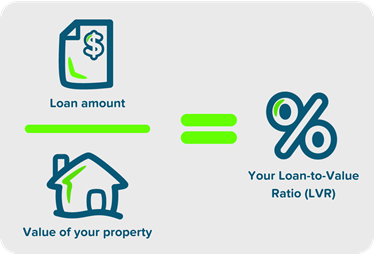If you’ve been doing your research on home loan products, you will have become familiar with the abundance of financial terms and abbreviations that are used. One of the more common terms you will see is Loan-to-Value ratio or ‘LVR’ for short.
What is LVR?
LVR a percentage figure which represents the amount you are borrowing against the value of the
property used to secure the loan.
For example, if you wanted to borrow a total of $450,000 and the property is worth $600,000, the LVR of the home loan would be calculated as:
($450,000 loan ÷ $600,000 property value) x 100 = 75% LVR.
It’s important to note that any upfront costs such as conveyancing and stamp duty aren’t included in the loan amount for LVR calculations.

Why is LVR important?
LVR is a key consideration in the assessment of your loan application. Lenders will generally consider an LVR under 80% of the property value to be lower risk. The bigger the home loan deposit you have, the lower your LVR will be and therefore the lower the risk your loan is to the bank.
Lenders will also typically offer better rates for loans with lower LVR, therefore you can minimise the amount of interest that you pay over the life of
your home loan by saving a larger deposit.
LVR and Lenders Mortgage Insurance
If your loan amount is more than 80% of the value of the property being used as security for the loan, you will need to have Lenders Mortgage Insurance (LMI).* LMI covers the lender against a loss in the event that you default on your loan. It is a one-off cost that can be paid upfront or added to the amount you borrow with repayments spread across the term of the loan.
What if I don’t have a 20% deposit?
Don’t worry, you still have options! Across all our MOVE Bank home loans, you can borrow up to a maximum 95% LVR for Owner-Occupied and a maximum 90% LVR for Investment purposes^.
For more information on our range of home loans or to speak with a lending specialist, visit movebank.com.au/home-loans.
*Subject to a satisfactory evaluation of the property.
^LMI required for loans over 80% LVR
This blog post is for general information purposes only and is not intended as financial or professional advice. It does not have regard to the financial situation or needs of any reader and must not be relied upon as financial product or other professional advice. You should seek your own independent financial, legal and taxation advice before making any decision about any action in relation to the material in this article.

